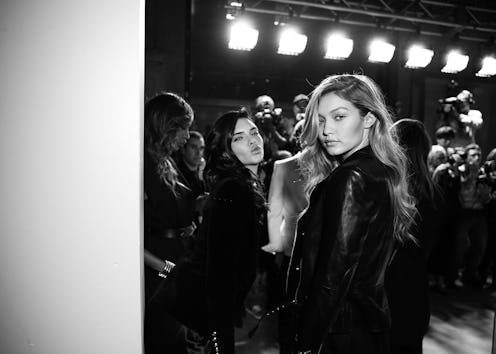What's the first thing you do when you wake up in the morning? If the answer is check Instagram, Facebook or Twitter, you're not alone. That connection has become a primal instinct for many of us.
So it's no surprise that accounts with millions of followers wield great power, and the pressure to amass a large, engaged audience has become increasingly paramount. This type of social currency—albeit hard to quantify—is an irrefutable pillar of modern popularity.
For the fashion community, and more specifically the industry's inner circle, social media has proven an indispensable tool, catapulting newbies to household-name status. It's been a big year for models: Gigi Hadid and Kendall Jenner perfectly demonstrate the correlation between online notoriety and professional success.
Kendall and Gigi at the Victoria's Secret Fashion Show. @gigihadid
It seems these two in particular have followed the example set by Cara Delevingne, who paved the way for the millennial model set in harnessing the power of the Web. Through Instagram and Twitter (where she sits at 24.1 million and 4.4 million followers, respectively), Cara was able to create and control her persona—one that sets her apart from the pack—and she rose quickly to big-time fame in the fashion world and beyond. She's vocal about how social media plays a role in her success: “I wouldn’t have done as well if I hadn't had that. Not at all. In the '90s, I wouldn't have been a supermodel,” she told The Wall Street Journal earlier this year.
Kendall and Cara face off. @caradelevingne
And while that may be true, it doesn't threaten her celebrity—rather, it shows a change in the landscape and a demand to remain strategic and nimble in a notoriously difficult industry, something Kendall and Gigi have embraced. The two continue to amass legions of loyal fans—on Instagram alone, Kendall boasts 44 million followers and Gigi has 10.2 million.
Steadily increasing numbers have no doubt had a hand in landing them huge gigs with major companies including Victoria's Secret (both), Estée Lauder (Kendall) and Versace (Gigi), as their ability to permeate the online masses adds serious value (read: exposure) for the brands. Just last week, Tommy Hilfiger announced a collaboration with Gigi and was transparent in connecting the dots: "We’re creating a line called Gigi by Tommy Hilfiger, using her style, her sense, her social media presence as the top supermodel in the world today.”
Whereas in the past models were notoriously elusive (think the nearly always silent Kate Moss), these girls make a case for the opposite, living their lives in front of millions and continuing their rapid ascent because of it. The next generation is already emerging—platinum-haired model siblings Lucky Blue Smith and Pyper America Smith (1.7 million and 560k followers on Instagram) have burst onto the scene from relative obscurity thanks to social media.
And it's not just models who've seen great change—designers and editors have taken aspects of their business from offline to online, oftentimes turning themselves into full-fledged fashion personalities in the process.
Olivier Rousteing with his #BalmainArmy posse of models. Getty Images
Take Balmain creative director and designer Olivier Rousteing, for example—just a few years ago someone in his position might have been unrecognizable outside the fashion industry. He’s now a household name, building an influential #BalmainArmy along the way. There's Eva Chen, the former Lucky editor-in-chief who left the print world altogether for a role as the head of partnerships at Instagram. And luxury brands are using social platforms to debut their collections—Misha Nonoo opted out of a traditional runway show and introduced her Spring 2016 line on Instagram, a first for the fashion community. Burberry followed a similar model on Snapchat, revealing its spring campaign on the platform this past October.
And on the topic of Snapchat, the app has emerged as this year's breakout star. A series of events—namely the rise of the "finstagram" and Essena O'Neill's viral testimonial about quitting social media—has indicated a shift to more real, raw content as audiences are becoming wise to the smoke and mirrors of overly curated, filter-heavy platforms like Instagram. Snapchat's lo-fi, gritty approach feels like a refreshing way to consume content.
While there are certainly exceptions to the rule (the social-media-averse Olsens, for one), innovating through social media continues to play a vital role in success among the fashion community. The tide shifted in 2015, and the ripple effect into 2016 is activity we'll definitely be following (and liking).
